Last year I published on this blog an extensive survey, aiming to learn about the common and successful management methods used in Israeli industry – and to get a current and full picture of the tools employed by managers in Israel in their daily work.
I examined 13 well-known and proven management methods from all over the world, which I myself use, and asked the participants to rank them through three questions: familiarity with the method, experience with the method, and how successful it was for them.
The answers are fascinating and detailed, and draw a full picture of the common management methods in Israeli industry – which are managers familiar with? Which are used? And which bring about success in various companies?
For managers this information is priceless – experience is the best teacher, and the ability to learn from other people's experience with successful methods is a great gift for every manager.
In this article I'll present the results and my analysis, based on my 30 years of experience as a manager and a consultant. The article is full of interesting data and I'll be happy to read your insights – I invite you to post them as a comment below. In the second part of my analysis (which will be published later this month) I discuss each of the 13 methods separately, based on the answers each one received regarding familiarity, experience, and success.
This is the second extensive survey I've published. A year before, I conducted, jointly with Anat Milner Cohen, a survey on the qualities needed in a successful manager, and the results were posted in 2017.
The statistical analysis was done with the help of Ori Amozeg, an industrial engineer.
Contents:
- About the survey and participants
- Transverse analysis of the 13 methods
- Familiarity with the methods
- Experience with the methods
- Success with the methods
- Summary
About the Survey and Participants
The survey examined 13 management methods: (1) creating a company vision, (2) creating a company strategy, (3) periodic work-plans, (4) quantitative goals, (5) using key performance indicators (KPIs), (6) improvement teams, (7) brainstorming, (8) sorting and prioritizing ideas, (9) the fishbone method, (10) the 5 whys method, (11) flow-charts, (12) the Pareto principle, and (13) Go See Think Do method.
349 blog readers participated in the survey, ranking the methods through three question: familiarity with the method, experience with method, and how successful the method was. For each question, participants ranked on a scale of 1 to 5, with 1 being the lowest score and 5 the highest.
Segmentation by age
1% of participants were aged 18-25, 30% were 26-40, 46% were 41-55, and 23% were 56 years old or older.
Segmentation by gender
70% of participants were men, and 30% women.
Segmentation by industry sector
83% were from the private sector, 12% from the government sector, and 5% from non-profits.
Segmentation by status
77% of participants were salaried, 15% business owners, 7% independent, and 1% students or pensioners.
Transverse Analysis of the 13 Methods
From the first part of the analysis, presented in this article, we'll be able to learn about which methods are familiar to Israeli managers, which are commonly used, and most importantly – which have proven successful.
The results show clear trends and strongly indicate which methods are often used, and which are less familiar to Israeli managers. I think managers in all levels can learn a lot from the results, and from the experience of survey participants, and to adopt methods which have proven successful in other companies.
Familiarity with the Methods
For the first question, participants were asked to rank the 13 methods based on how familiar they were with them, on a scale of 1 (not familiar) to 5 (very familiar). This question examined if participants were knowledgeable about the various methods.
Ranking the Methods
We counted points simply: every vote of "1" got the method 1 point, a vote of "2" got 2 points, and so on. Since the number of voters was almost the same for all methods, arranging them by accumulated points shows those most known in the Israeli industry, as opposed to least known ones:
We can see that 7 methods out of the 13 are well-known (over 70%).
The methods "quantitative goals", "periodic work-plans", and "using indicators" were ranked first with an almost identical number of points. This is a positive situation showing good awareness of forward planning, setting goals and indicators, and monitoring them.
Based on my personal experience, there are many companies which don't use set goals and indicators. But in any case it seems these methods are at least well-known, and they reached the first places in the survey.
It's worth mentioning that in a short survey we had about "how your company treats goals and indicators?", only 29% of participants answered that their company uses goals, indicators and improvement plans. At the same time, 25% answered their company uses no such methods. All other participants reported their companies had goals but, in their opinion, those were not monitored and there were no work-plans for achieving them.
"Brainstorming" reached the fourth place, then "creating a company vision" and "creating a company strategy".
It's interesting to see that out of the 6 methods places in the top, 5 are used in the macro level. These are methods used by managers in all levels and roles, and are taught in academic institutions – it's then not surprising they places high in the familiarity ranking.
"Brainstorming" was the highest ranked micro level method. The rest of the micro level methods were ranked lowest, as you can see.
The "Pareto principle (20-80 principle)" came seventh in the familiarity ranking, then "flow-charts", "improvement teams", and "sorting and prioritizing ideas".
In the last three places, by a high margins, are the "fishbone" method, the "5 whys", and the "Go See Think Do" method.
It's interesting that as a method is more specific – that is, meant to address a specific problem – the less familiar it is – certainly when compared to the "big" methods like creating strategies and work-plans.
It's interesting – and it's a pity – since successful management is also dependent on the micro level: the production floor, solving faults and bottle-necks, chain of supply, warehouse management, and other "small" issues that are nonetheless just as important.
The 6 or 7 methods ranked last are ones meant to promote efficiency and focus and in many cases solve problems, but are often not part of routine work. These are also methods that, it seems, aren't taught in universities.
We can see that of the last 6 methods, the 3 "more well-known" ones were ranked as somewhat known (70%-45%) while the other 3 were not known (<45%).
Votes Distribution
The following graph shows the distribution of votes regarding level of familiarity for each method. You can see the percentage of participants who voted for each option:
It's interesting to see that the 3 lowest ranked method – "fishbone", "5 whys", and "Go See Think Do" – are the only ones for which the number of 1 votes (not familiar) was higher than all other options, and distinctly so. For all other methods, with no exception, the most votes went to 5 (very familiar) – and their rank was determined by votes distribution between 5, 4, and 3.
That is, apart from the last 3 methods, all methods are widely known in Israeli industry, and the difference between them is in the level of familiarity – with the macro methods being more familiar to most participants, while the rest were familiar only to a (large) part of them, and somewhat familiar to the rest.
A more focused analysis of this graph could lead to many further conclusions, but I don’t want to spend too much time on it, as this article is already full of data. You, the readers, are invited to add your analysis and conclusions in the comments below.
Experience with the Methods
For the second question, participants were asked to rank the 13 methods based on their experience with them, from 1 (no experience) to 5 (I regularly work with this method). The following graphs will present the more familiar methods, according to the survey answers, and the votes distribution for each one.
Unlike the level of familiarity with the methods, which addressed theoretical knowledge only, this question deals with practicalities and gives a clear picture of the management methods which are widely used, or not, in Israeli industry.
In addition, it's interesting to see the differences between levels of familiarity and experience, and to think about the meaning of these differences.
Ranking the Methods
We counted the votes the same way as with the previous question: every vote of "1" gave the method 1 point, a vote of "2" – 2 points, and so on. The results are similar to those regarding familiarity – which points to a high percentage of assimilation of known methods:
It's interesting to see the final points tally was lower for all methods. We might expect that the tally would be identical, or similar, to the previous question, because there's an expectation that if someone knows a method, they'd use it in practice.
The difference shows a disparity between familiarity and experience levels – which could be caused by a wide variety of reasons.
In this graph we can see that 4 methods, of the 8 well-known ones, are ones managers in all levels and roles have routine experience with to a high extant (65%<). It's important to note that these are the same method which were highest ranked in the previous question, in the same order: "quantitative goals", "periodic work-plans", "using indicators", and "brainstorming".
The 3 leading methods are used to plan and measure work in an orderly way – and it's good to see they lead the ranking. This indicates that companies in Israel (or at least those whose managers participated in the survey) work in a defined and planned way, and use goals and indicators for improvement.
Unlike with the previous question, this one shows 6 methods which are moderately used in routine work (45%<-60%>), methods which have in common that they don’t use quantitative or numerical definitions. They are more macro methods to manage a business: "creating a company vision", "creating a company strategy", "sorting and prioritizing ideas", "improvement teams", "flow-charts", and the "Pareto principle".
Like the results of the previous question, the 3 least employed methods (45%<), according to this survey, are less popular methods because, it seems, they're studied less in academic institutions, out of industrial engineering departments, and maybe also because these are methods for identifying a crisis or a problem, and for planning work "from above": "fishbone", "5 whys", and "Go See Think Do".
The method which lost the most points from the previous question is the Pareto principle. For familiarity, it was ranked seventh. For experience, it was ranked tenth. In its place, in a switch, the sorting and prioritizing ideas method moved up from number 10 to number 7.
Votes Distribution
The following graph presents the votes distribution for levels of experience for each method. You can see the percentage of participants who voted for each option:
Here, as with levels of familiarity, the 3 lowest ranked methods – "fishbone", "5 whys", and "Go See Think Do" – had a distinct majority of votes going to "1" (no experience). However, for the rest of the methods distribution is more varied than in the previous question.
The 4 leading methods ("quantitative goals", "periodic work-plans", "using indicators", and "brainstorming") had a distinct majority of votes going to "5", but that majority was, for the most part, less distinct than in the previous question.
For the fifth ("creating a company strategy") to tenth ("Pareto Principle") ranked methods we can see a greater variety of distribution – though for all the number of "1" votes exceeded that of "2" votes. For "improvement teams", "flow-charts", and the "Pareto principle" – option "1" (no experience) came second after option "5" (I regularly work with this method) – an interesting data point suggesting relatively polar attitudes towards these methods – most participants either had experienced/worked with them, or had no experience at all.
It's very interesting to see the differences between the level of familiarity with the methods and the level of experience. It suggests, among other things, a great opportunity for improvement – if managers make a greater effort to use and apply the management methods they know.
From my 30 years of experience I know that each of these methods can directly contribute to a company's profit, its daily operations and the level of work. The survey data suggest the "problem" in many cases isn't a lack of knowledge – but rather unwillingness and/or inability to apply the knowledge.
Without a doubt, this is a great opportunity for many managers to improve their level of work and their company's performance.
Like in the previous part, I took pains to shorten my analysis, while focusing on what are in my opinion the most important conclusions. I'll be happy to hear what you think and your analysis of the data in the comments below.
Success with the Methods
This is without a doubt the most important question for anyone looking to choose a management method to implement in their work in order to improve profit and results.
For this question, participants were asked to rank each method based on the level of success they had with it, from 1 (no success) to 5 (great success).
The answers point to the management methods which created success in the work of the participating managers, even though the survey didn't check if the method was implemented in a smart, correct, and appropriate manner – but only the level of success achieved - the large number of votes enables us to carry out a reliable statistical analysis of the methods.
Ranking the Methods
[Normalizing the data: how was this data measured in the survey?
In order to achieve reliable results regarding the level of success working with each method – we removed from this part all the participants who reported having no experience with the method or not knowing it. Someone who has no experience with a method can't report success or lack of it, naturally. That is of course also the case with someone who doesn’t know the method.]
So the results for the level of success with each method are based only on participants who had experience with it. That way we could ensure the data on success for each method was based only on answers by managers who actually used it.
In accordance with that, the results are presented differently for this question. Instead of accumulated points, we ranked the method based on the percentage of participants who chose 4 or 5. In the first place are methods with the highest percentage of 4 or 5 answers.
In addition, the graph also shows the percentage of participants who chose 1 or 2, that is, didn’t have success with the method.
3 methods showed great success (over 70%): "quantitative goals", "periodic work-plans", and "using indicators". All three are common methods used by almost all companies. Furthermore, all three are quantitative and measurable.
In every company I managed or consulted I emphasize creating clear indicators and goals, and a clear work-plan. I always see these methods bring great success, and I'm happy to see that the overwhelming majority of participants who had experience with these methods reported similar success.
Only (approximately) 10% of participants who had experience with the methods reported not having success with them.
It's also interesting to see the methods leading in success were the highest ranked in the rest of the survey as well.
4 methods were ranked as successful (70%-60%), and they're each different: "Brainstorming", the "Pareto principle", "creating a company strategy", and "sorting and prioritizing ideas". In my experience, only senior management works on a company's strategy, while the rest of the methods ranked in this bracket are often used by managers at all levels.
It's interesting to see that the Pareto principle, which was low ranked in the question on level of experience, came fifth in this question. This is certainly a powerful method and a correct use of it can focus a company on what's important and greatly improve its success.
4 methods were ranked as moderately successful: "improvement teams", "creating a company vision" "flow-charts", and "5 whys". Like with the previous bracket, here too is one method that is used by senior management - "creating a company vision" – while the other 3 methods are professional ones, each in its field.
Even though no more than 60% of participants answered 4 or 5 regarding their success with these methods, less than 20% answered 1 or 2, that is reported a lack of success (except for the "5 whys" method). In other words, the overwhelming majority of participants (80%) experienced some success working with these methods.
"Creating a company vision" was highly ranked in the familiarity and experience questions (sixth in both), but was ranked ninth in this one. It'll be interesting to know if that's due to failure to create an appropriate and correct vision, or a lack of ability to connect its creation with resulting success – vision is an amorphous thing and it's difficult to measure its direct influence on work and results – although in my experience, a vision is very important in order to steer the whole company in the right direction.
The 2 methods which were ranked lowest (below 50%) – "Go See Think Do" and "fishbone" – were low ranked throughout the survey (familiarity, experience, success). Furthermore, over 33% of those who had experience with these methods reported a lack of success with them.
In my experience these are strong and good methods, and it'll be interesting to know why participating who had experience with them didn't report success. Perhaps it's due to incorrect use, working in an environment that doesn’t support the process, or other reasons I haven’t thought of. Either way, in my long experience these are good methods.
I encourage you, the readers, in case you don’t use these methods, to implement them in your companies and see the success they can bring for yourself.
If you have different or further insights or conclusions I'll be happy to read them in the comments below.
Votes distribution
The following graph presents the votes distribution for each method. You can see the percentage of participants who voted 1, 2, 3, 4 or 5 for each one:
One very interesting point I can see in the votes for each method is that for 11 of them – all barring "Go See Think Do" and "fishbone" – an overwhelming majority of participants voted 3, 4 or 5 – that is, some level of success.
Overall, this shows the validity of methods which were developed, tried and refined over the years – and the importance of managing and working with ordered and proven methods. The data shows that when you work with good management methods – you succeed.
Even the 2 methods ranked last had a majority of 3, 4 or 5 votes, though not an overwhelming one.
For the 3 leading methods, over 40% of participants chose "5" (great success) and less than 5% chose "1" (no success).
Summary
The results clearly show the management methods used by managers in Israel: which are widely familiar, which are successful.
The 13 methods I examined in the survey are known, proven and common in global industry – methods which were developed and refined over years by managers from different countries, different industries, and companies of all types and sizes.
To managers who don't yet use the most successful methods, as ranked in the survey, I suggest they hurry and implement at least some of them in their daily work – I have no doubt that a thoughtful use of these method will always lead to improvement in results, work, and profit.
In my experience, the methods ranked lowest in the question on levels of success are also strong methods which can create success and improvement. It's possible they require more precise use.
Finally – for managers who want to innovate or who work in a very competitive environment – the survey suggests a big opportunity – to implement in their companies less common management methods, and thus create for themselves a relative advantage.
In the second part of my analysis I will present the data for each one of the 13 methods separately, in a way which allows for a more extensive view of familiarity, experience, and success for each.
If you have conclusions based on the presented data, or if you're willing to share your experience, I'll be happy to read your opinions in the comments below.
If you are interested in my professional help, personally or for your company, the best way to contact me is to send a request through the Get in Touch form here.

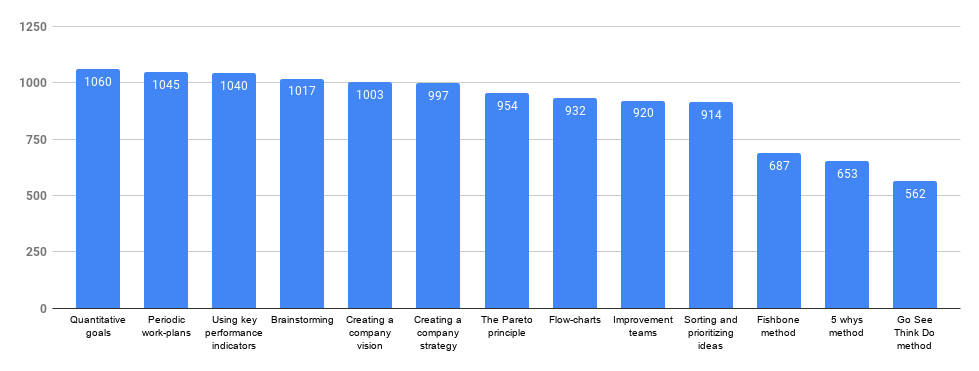
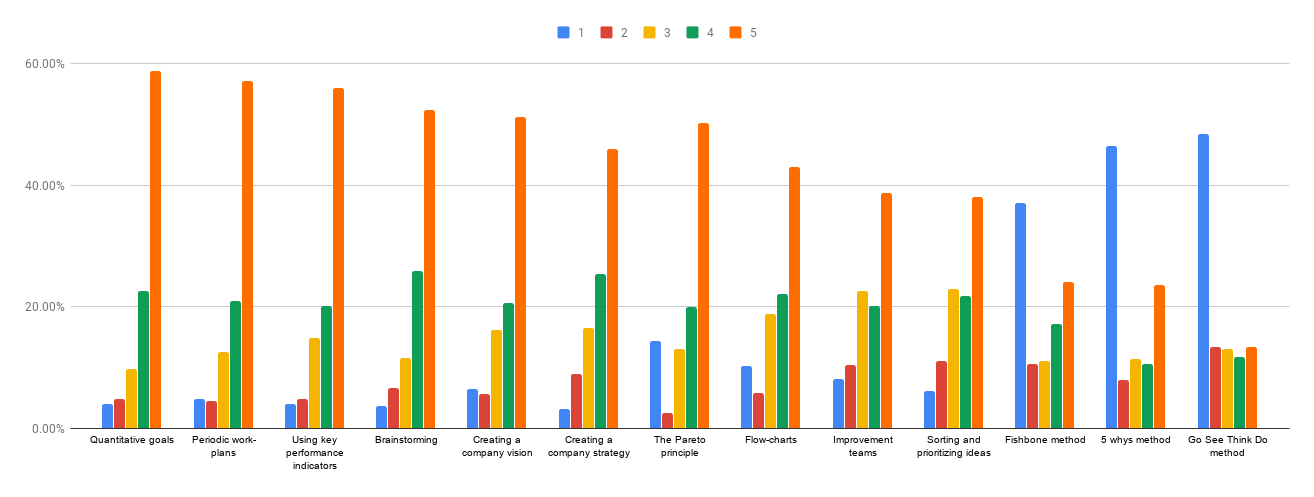
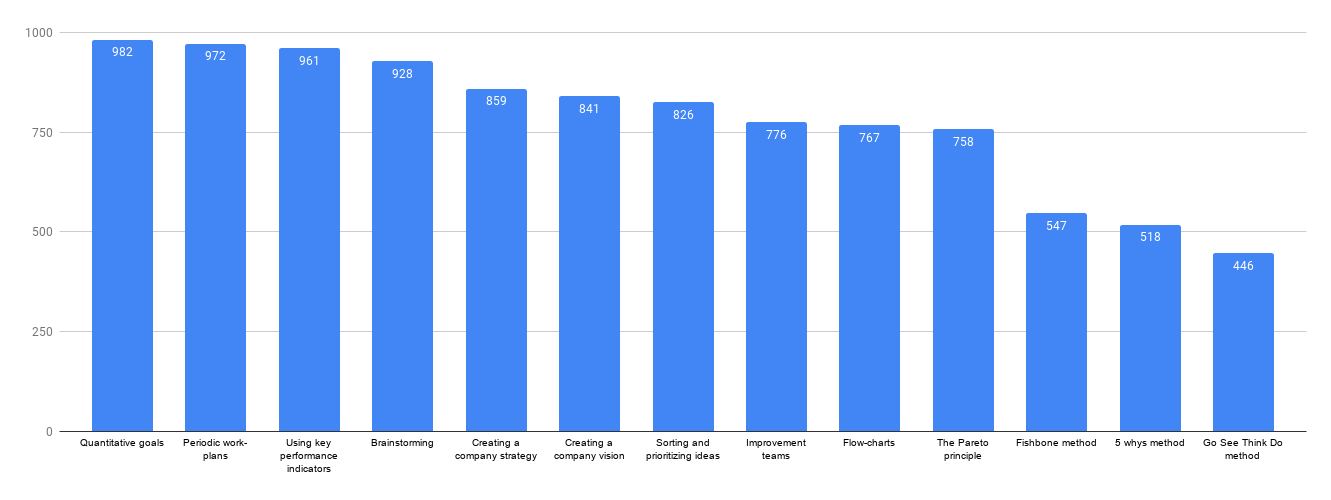
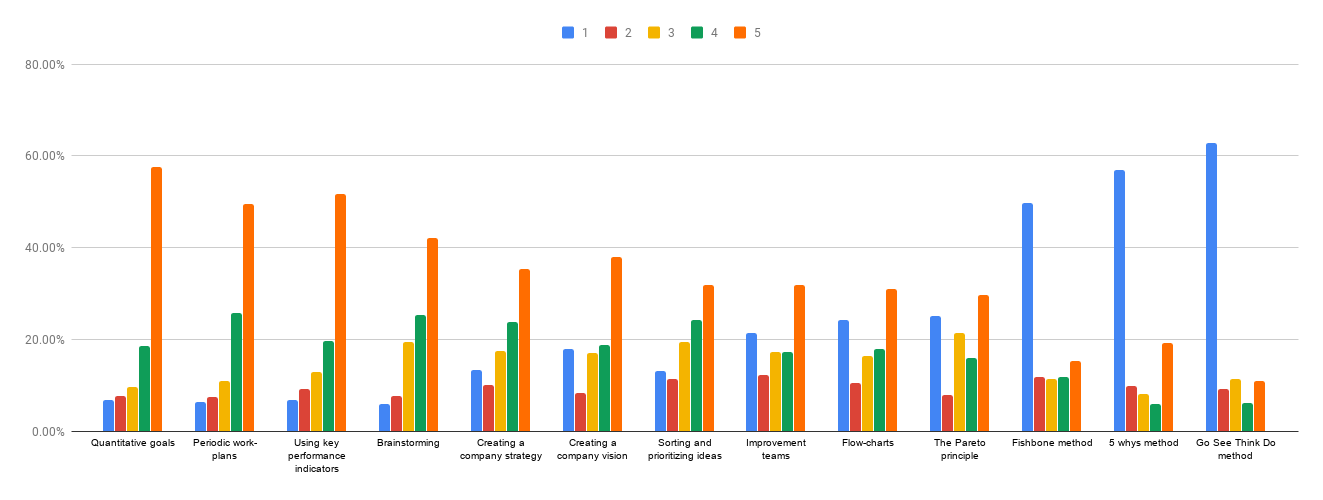
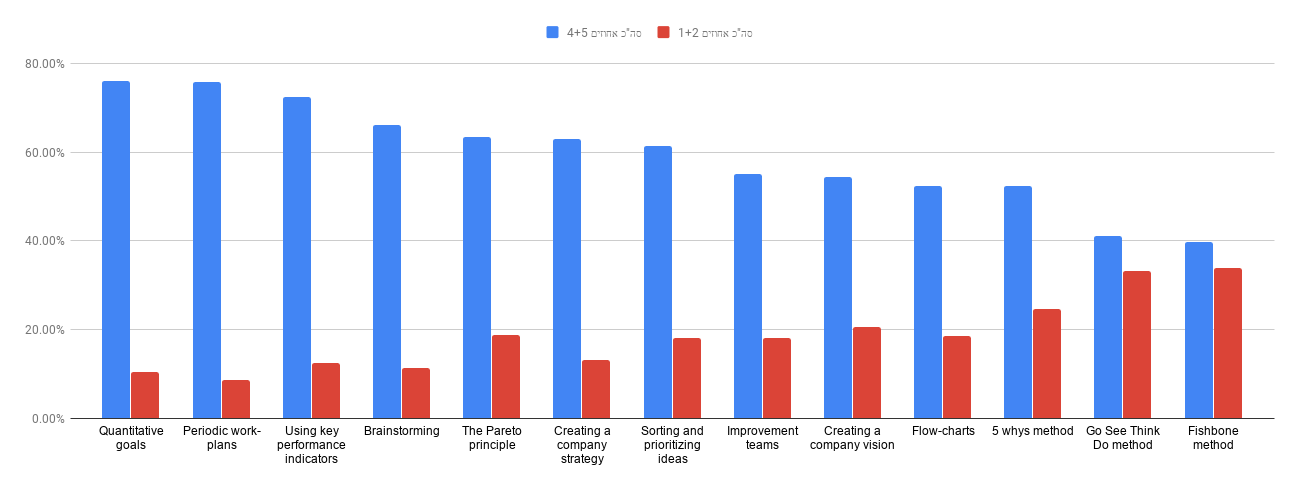
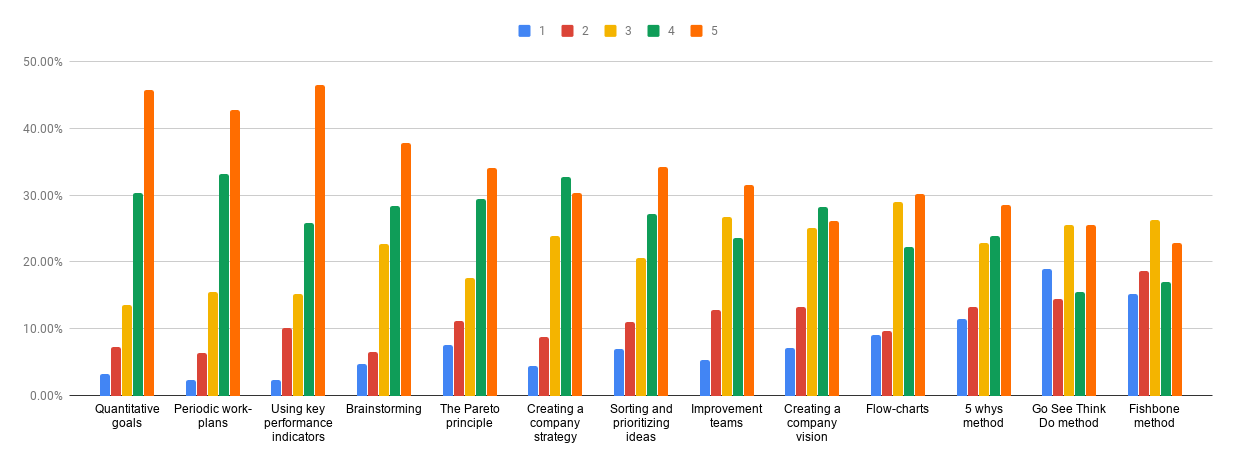









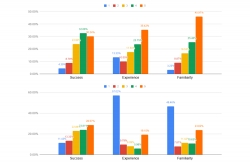

 My First Book: Manage! Best Value Practices for Effective Management
My First Book: Manage! Best Value Practices for Effective Management